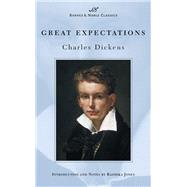From Radhika Jones's Introduction to Great Expectations
Whatever expectations Charles Dickens had for his thirteenth novel, he probably did not anticipate that it would someday come to exemplify the Victorian novel itself. But to the countless contemporary readers who follow the adventures of young Pip, the convict he fears, the girl he loves, and the strange old woman he thinks will make his fortune, Great Expectations is in many ways the quintessential nineteenth-century story: part mystery, part bildungsroman, or novel of education, in which our hero, rising above his modest beginnings, moves to London, prospers, and eventually (he hopes) gets the girl. Pip's course, however, does not run so smoothly, and it is the variations Dickens plays on this theme that prompt us to read Great Expectations both with and against the grain of the Victorian novel, for at times it is less an emblem of tradition than a marker of change in both the English society it depicts and the English novel it represents. There are surprises at work in Great Expectations for both its characters and its readers, who bring to it their own expectations of what a novel should be and do.
A caricature of Dickens displayed in bookstores when the first sections of Great Expectations appeared (in serialized form, as was common for novels in the Victorian era) shows the author at his desk, pen in hand, hair standing on end, exuding genius. The caption reads, "Charles Dickens, from whom we have Great Expectations." Though the pun is obvious, it is worth recalling for the simple reason that it sounds oddly forward-looking, like something one would say of a promising young writer at the beginning of his career. When Dickens began Great Expectations, at age forty-eight, he already had a dozen novels to his name, as well as countless short stories; he was also an accomplished and experienced editor, a powerful publisher, and a prolific generator of nonfiction-articles, editorials, sketches, and so on. Thanks to both his own prodigious skills and the remarkable rise in literacy rates in nineteenth-century England and America-a fortuitous combination of talented writer and eager new readership-Dickens was one of the first bona-fide mass-market writers in history, a best-selling author and, as novelist Jane Smiley observes in a recent biography, "maybe the first true celebrity in the modern sense." If the world had Great Expectations of Dickens, those expectations could be only that he would continue to deliver a product of which he himself was the most significant producer: compelling stories that appeared in monthly or weekly installments to entertain and inform. And so the caricature's caption reminds us of Dickens's intimate relationship to his readership; the novels he produced went from his pen to their hands with a kind of immediacy that no longer exists in the world of fiction outside of journalism. With every installment of his new novel, Dickens would fulfill expectations, even as he stoked the public's appetite for more.
The writing of Great Expectations coincided roughly with a new phase in Dickens's life and career. He had recently left his wife, Catherine, mother of his ten children, and had embarked on a very private affair with a young actress, Ellen Ternan. He had also discontinued his immensely popular weekly journal Household Words, of which he was editor and part-owner, after his copublishers took issue with his decision to print a personal statement, intended to refute rumors about his dissolving marriage, on the front page. Now Dickens was editor of a replacement journal, All the Year Round, in which his historical novel A Tale of Two Cities debuted. Shortly after finishing that work, he began contributing chapters of Great Expectations to boost the circulation, which was sagging due to a lackluster serial by Charles Lever that was then running. (As Dickens's friend and biographer John Forster wryly notes: "A tale, which at the time was appearing in his serial, had disappointed expectation.") Dickens called a staff meeting to discuss options, but he had already decided on a course of action: It was time for him to "strike in." His faith in his selling power did not go unrewarded; circulation of the weekly rebounded and remained healthy for the rest of Dickens's career. But his decision had an impact on the story he was envisioning before it even reached the page. According to Forster, Dickens was planning to compose his new novel-for which he had already conceived the pivotal relationship, between a young boy and a convict-in monthly serial form, comprising twenty numbers, which would have made it a much longer work on the scale of such previous hits as Dombey and Son and Little Dorrit. Publishing it in his weekly journal would require Dickens to reconfigure his idea into a shorter book, along the lines of its predecessor, A Tale of Two Cities. The result is a novel more pruned in its plots, more limited in its cast of characters than others of Dickens's great works. It was a "sacrifice," Dickens told Forster, "really and truly made for myself"-a compromise between Dickens the publisher and Dickens the writer. Thus was Great Expectations born: out of disappointed expectation, transformed from its creator's original expectation. The meanings inscribed in its title had already begun to multiply.
